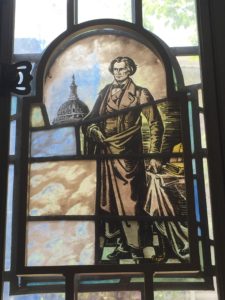
A year-long student-led campaign could not bring about a name change. But that does not mean students should expect to see the same old Calhoun College when they return in August.
In a Tuesday night email to the Calhoun community, Head of Calhoun College Julia Adams announced a series of changes to the college building — the latest steps in a reconciliation effort designed to bring students together in the aftermath of the University’s controversial decision to retain the name Calhoun.
Adams’ email outlined two key changes: a set of stained-glass windows depicting Calhoun will be removed from the common room, and the college dining hall will be named after Roosevelt Thompson ‘84, a Calhoun alumnus whose record of public service and academic achievement made him a popular candidate for the renaming of the college.

“My goal is to have things ready for Hounies’ return to campus,” Adams told the News. “Placating people wasn’t in my mind. Rather I hope that the specific mingling of old and new, in which the students and broader Calhoun community will have a hand, opens to the future as well as the past.”
According to Adams’ email, the Calhoun windows — which depict various moments from the statesman’s life — will be stored for conservation and study at the Yale University Art Gallery, and temporarily replaced with tinted glass. Later this fall, a University panel will commission an artist to design permanent replacements for the windows.
It is not the first time a student protest movement has led to the removal of stained-glass panels from the college. In 1992, students successfully campaigned for the removal of a panel in the common room that depicted a shackled slave kneeling at Calhoun’s feet.
But last year, as racially-charged protests roiled college campuses across the country, student activists at Yale adopted a more ambitious goal: the renaming of Calhoun College, named for notorious slavery advocate John C. Calhoun, class of 1804.
In April, the Yale Corporation, which had final jurisdiction over the naming dispute, elected to retain the college name in defiance of student demands.
Still, Adams — who proposed renaming the college Calhoun-Douglass, after the 19th-century abolitionist Frederick Douglass — showed a willingness throughout the spring semester to act independently of the Corporation in distancing the college from the troubling legacy of its namesake.
In January, she ordered the removal of three oil paintings of Calhoun, including a scowling portrait that had hung in the dining hall since the 1930s. And she first suggested naming the dining hall after Thompson — a popular, high-achieving African American student who died tragically two months before his graduation — just hours after the naming decision was announced.
Adams may struggle, however, to satisfy student activists still grappling with a decision that felt to many like an unforgivable betrayal.
Austin Strayhorn ’19, a Calhoun student who belongs to the Black Men’s Union, said he welcomed the changes but still resents the overall naming decision.
“There are no consolation prizes in this war,” Strayhorn said.
But Alex Zhang ’18 — whose Jan. 25 column in the News helped ignite a student campaign to name the college after Thompson — expressed enthusiasm about the prospect of a Roosevelt Thompson dining hall.
“The dining hall, one might argue, is a centerpiece in residential college life,” Zhang told the News. “It represents community, fellowship, and joy. Roosevelt Thompson demonstrated those values to the fullest.”







